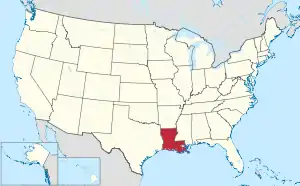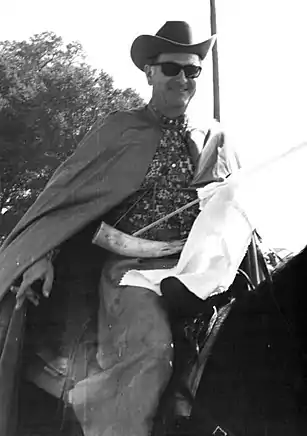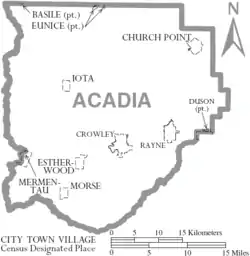Acadia Parish, Louisiana
Acadia Parish (French: Paroisse de l'Acadie) is a parish located in the U.S. state of Louisiana. As of the 2010 census, the population was 61,773.[2] The parish seat is Crowley.[3] The parish was founded from parts of St. Landry Parish in 1886, and later an election was held to determine the parish seat, ending when Crowley beat Rayne and Prairie Hayes.[4]
Acadia Parish | |
|---|---|
Parish | |
| Parish of Acadia | |
 Acadia Parish Courthouse | |
 Location within the U.S. state of Louisiana | |
 Louisiana's location within the U.S. | |
| Coordinates: 30°16′N 92°24′W | |
| Country | |
| State | |
| Founded | 1886 |
| Named for | The Acadians |
| Seat | Crowley |
| Largest city | Crowley |
| Area | |
| • Total | 657 sq mi (1,700 km2) |
| • Land | 655 sq mi (1,700 km2) |
| • Water | 2.3 sq mi (6 km2) 0.4% |
| Population (2010) | |
| • Total | 61,773 |
| • Estimate (2018)[1] | 62,190 |
| • Density | 94/sq mi (36/km2) |
| Time zone | UTC−6 (Central) |
| • Summer (DST) | UTC−5 (CDT) |
| Congressional district | 3rd |
| Website | www |
Acadia Parish is included in the Lafayette, Louisiana metropolitan statistical area.
History
The name of the parish is derived from the former French colony of Acadia in Canada (which consisted of the modern provinces of Nova Scotia, Prince Edward Island, New Brunswick, and much of Maine), many of whose French-speaking inhabitants were deported to France and then migrated to Louisiana in the Great Upheaval (see Cajuns).
The parish itself was formed from the southwestern portion of St. Landry Parish. On Wednesday May 19, 1886, a bill was introduced in the house entitled "An act to create the parish of Nicholls, and to provide for the organization thereof." The title was later changed to read: "An act to create the parish of Acadia." Father Joseph Anthonioz, the first pastor of the Catholic Church at Rayne, is credited with having suggested the name, Acadia Parish. The bill passed the house on June 11, the senate on June 28, and was approved by Governor Samuel D. McEnery on June 30.[5] On October 6, an election was held to affirm the creation of the parish, with 2,516 votes for and 1,521 votes against the creation. The population of the new parish was from 10,000 to 12,000. Acadia Parish population in 1890 was 13,231.[6]
After a close election held on March 1, 1887, Crowley was chosen as the parish seat, gathering 698 votes to Rayne's and Prairie Hayes' 560 and 519, respectively. The election also determined the first officers in the parish: Elridge W. Lyons, first sheriff of Acadia, and R. T. Clark, first clerk of court. The first courthouse was therefore constructed in Crowley and completed on June 30, 1888, and continued to be used until May 1, 1902, when it was destroyed to make way for the second building.[7]
Geography
According to the U.S. Census Bureau, the parish has a total area of 657 square miles (1,700 km2), of which 655 sq mi (1,700 km2) are land and 2.3 sq mi (6.0 km2) (0.4%) are covered by water.[8]
Major highways
 Interstate 10
Interstate 10 U.S. Highway 90
U.S. Highway 90 Louisiana Highway 13
Louisiana Highway 13 Louisiana Highway 35
Louisiana Highway 35 Louisiana Highway 91
Louisiana Highway 91 Louisiana Highway 92
Louisiana Highway 92 Louisiana Highway 97
Louisiana Highway 97
Adjacent parishes
- Evangeline Parish (north)
- St. Landry Parish (northeast)
- Lafayette Parish (east)
- Vermilion Parish (south)
- Jefferson Davis Parish (west)
Demographics
| Historical population | |||
|---|---|---|---|
| Census | Pop. | %± | |
| 1890 | 13,231 | — | |
| 1900 | 23,483 | 77.5% | |
| 1910 | 31,847 | 35.6% | |
| 1920 | 34,820 | 9.3% | |
| 1930 | 39,326 | 12.9% | |
| 1940 | 46,260 | 17.6% | |
| 1950 | 47,050 | 1.7% | |
| 1960 | 49,931 | 6.1% | |
| 1970 | 52,109 | 4.4% | |
| 1980 | 56,427 | 8.3% | |
| 1990 | 55,882 | −1.0% | |
| 2000 | 58,861 | 5.3% | |
| 2010 | 61,773 | 4.9% | |
| 2018 (est.) | 62,190 | [9] | 0.7% |
| U.S. Decennial Census[10] 1790–1960[11] 1900–1990[12] 1990–2000[13] 2010–2013[2] | |||
As of the 2010 United States Census, 61,773 people were residing in the parish; 79.5% were White, 18.1% African American, 0.3% Native American, 0.3% Asian, 0.6% of some other race and 1.3% of two or more races. About 1.7% were Hispanic or Latino (of any race). 43.7% were of French, French Canadian or Cajun, 10.8% American, and 8.0% German ancestry.[14]
As of the census[15] of 2000, 58,861 people, 21,142 households, and 15,666 families were living in the parish. The population density was 90 people per square mile (35/km2). The 23,209 housing units averaged 35 per square mile (14/km2). The racial makeup of the parish was 80.73% White, 18.25% African American, 0.20% Native American, 0.15% Asian, 0.21% from other races, and 0.47% from two or more races. Around 19.04% reported speaking French or Cajun French at home.
Of the 21,142 households, 38.50% had children under the age of 18 living with them, 54.50% were married couples living together, 14.90% had a female householder with no husband present, and 25.90% were not families. About 22.60% of all households were made up of individuals, and 10.30% had someone living alone who was 65 years of age or older. The average household size was 2.74, and the average family size was 3.22.
In the parish, the age distribution was 29.80% under 18, 9.60% from 18 to 24, 27.40% from 25 to 44, 20.90% from 45 to 64, and 12.30% who were 65 years of age or older. The median age was 34 years. For every 100 females, there were 93.50 males. For every 100 females age 18 and over, there were 88.80 males.
The median income for a household in the parish was $26,684, and for a family was $31,812. Males had a median income of $29,353 versus $17,179 for females. The per capita income for the parish was $13,424. 24.50% of the population and 21.00% of families were below the poverty line. 30.30% of those under the age of 18 and 25.20% of those 65 and older were living below the poverty line.
Arts and culture

Many festivals and cultural celebrations are held annually in Acadia Parish, including the International Rice Festival in Crowley, Frog Festival in Rayne, and Buggy Festival in Church Point. Cajun food and music, both specialties of the local population, feature prominently in these festivals.
Several communities in Acadia Parish celebrate the tradition of Courir de Mardi Gras. Disguised with masks and costumes, Cajuns travel through their rural neighborhoods, making merry while begging for gumbo ingredients. The gumbo is the centerpiece of a communal supper and dance.
Education
Acadia Parish is served by Acadia Parish Schools .
- Acadia Parish Head Start - Church Point
- Church Point Elementary (grades PK-5) (Church Point)
- Church Point Middle (grades 6-8) (Church Point)
- Church Point High (grades 9-12) (Church Point)
- Acadia Parish Head Start - Rayne
- Central Rayne Kindergarten (grades PK-1) (Rayne)
- Martin Petitjean Elementary (grades 1-3) (Rayne)
- South Rayne Elementary (grades 4-5) (Rayne)
- Armstrong Middle (grades 6-8) (Rayne)
- Rayne High (grades 9-12) (Rayne)
- Acadia Parish Head Start - Crowley
- Crowley Kindergarten (grades PK-K) (Crowley)
- North Crowley Elementary (grades K-5) (Crowley)
- Ross Elementary (grades K-5) (Crowley)
- South Crowley Elementary (grades K-5) (Crowley)
- Crowley Middle (grades 6-8) (Crowley)
- Iota Elementary (grades PK-5) (Iota)
- Iota Middle (grades 6-8) (Iota)
- Iota High (grades 9-12) (Iota)
- Acadia Parish Head Start - Estherwood
- Branch Elementary (grades PK-8) (Branch)
- Egan Elementary (grades PK-8) (Egan)
- Estherwood Elementary (grades PK-7) (Estherwood)
- Evangeline Elementary (grades PK-8) (Evangeline)
- Mermentau Elementary (grades PK-7) (Mermentau)
- Mire Elementary (grades PK-8) (unincorporated Rayne)
- Morse Elementary (grades PK-7) (Morse)
- Richard Elementary (grades PK-8) (unincorporated Church Point)
- Crowley High (grades 9-12) (unincorporated Crowley)
- Midland High (grades 8-12) (unincorporated Midland)
Acadia Parish is also served by the Roman Catholic Diocese of Lafayette with five schools:
- St. Francis School (grades PK-8) (Iota)
- Rayne Catholic Elementary School (grades PK-8) (Rayne)
- St. Michael Elementary School (grades PK-8) (Crowley)
- Our Mother of Peace Elementary School (grades PK-8) (Church Point)
- Notre Dame High School (grades 9-12) (Crowley)
Additionally, Acadia Parish is served by one unaffiliated private school:
- Northside Christian School (grades PK-12) (Crowley)
Acadia Parish is served by two institutions of higher education:
- Louisiana State University, Eunice (Eunice)
- South Louisiana Community College, Acadian Campus (Crowley)
National Guard
C Company 3-156TH Infantry Battalion resides in Crowley, Louisiana. As part of the 256th IBCT, this unit deployed to Iraq twice, 2004-5 and 2010.
Communities

Towns
Villages
Other unincorporated communities
- Arceneaux
- Bates
- Bluff
- Castile
- Deshotel
- Ebenezer
- Ellis
- Evangeline
- Frey
- Gatte's Cove
- Gumpoint
- Hundley
- Judd
- Keystone
- LeJeune Cove
- Link
- Little Japan
- Lyons Point
- Maxie
- Mermentau Cove
- Midland
- Millerville
- Mire (formerly Marais Bouleur and Bosco)
- Mowata
- Nezpique
- Peach Bloom
- Pitreville
- Pointe Noire
- Prairie Hayes
- Prudhomme
- Richard
- Ritchie
- Robert's Cove
- Rork
- Shortbread
- Tepetate
- Tortue
- Whitehouse
- Williams
More information on these communities can be found at https://web.archive.org/web/20070525094238/http://www.acadia.lib.la.us/newpage1.htm
Notable people
- Bill Cleveland, Crowley real estate developer and member of both houses of Louisiana state legislature from 1944 to 1964; defeated for third term in state senate in 1964 by Edwin Edwards
- Francis Dugas, state representative from Lafourche Parish from 1956 to 1960, was born in Rayne in Acadia Parish in 1919.
- Paul B. Freeland coauthored Acadia Parish, Louisiana: A History to 1900. His collection of photographs and memorabilia of the Crowley area can be accessed from the archives of the Acadia Parish Library in Crowley.
- George Stanley, sculptor for the design of the Oscar statue and the Muse Sculpture at the Hollywood Bowl
- Mary Alice Fontenot, journalist and author of children's books and books on Louisiana history
- Sidney Brown, a musician from Church Point (28 October 1906 - 6 August 1981) who was known as one of the first accordion makers and repairmen in Louisiana. Brown also has the distinction of having recorded the third-best selling Cajun music album of all-time (Noir Chaussette's "Two Step/Pestauche Taunte Na Na").
- John Breaux, a retired U.S. Senator, is a native of Acadia Parish.
- Edwin Edwards, a former Louisiana governor (four terms), lived and worked in Acadia Parish for many years. His political career began on the Crowley City Council.
Politics
| Year | Republican | Democratic | Third parties |
|---|---|---|---|
| 2020 | 79.5% 22,596 | 19.2% 5,443 | 1.4% 386 |
| 2016 | 77.3% 21,162 | 20.6% 5,638 | 2.2% 589 |
| 2012 | 74.3% 19,931 | 24.5% 6,560 | 1.3% 344 |
| 2008 | 72.0% 19,229 | 26.3% 7,028 | 1.7% 454 |
| 2004 | 63.8% 16,083 | 35.4% 8,937 | 0.8% 210 |
| 2000 | 59.5% 13,814 | 38.3% 8,892 | 2.3% 532 |
| 1996 | 38.6% 9,246 | 51.4% 12,300 | 10.0% 2,381 |
| 1992 | 36.7% 9,017 | 50.0% 12,276 | 13.3% 3,275 |
| 1988 | 49.0% 11,319 | 49.8% 11,510 | 1.2% 281 |
| 1984 | 60.6% 14,906 | 37.7% 9,262 | 1.8% 434 |
| 1980 | 52.2% 11,533 | 45.0% 9,948 | 2.8% 619 |
| 1976 | 35.7% 6,296 | 61.3% 10,814 | 3.1% 538 |
| 1972 | 63.8% 9,698 | 29.0% 4,406 | 7.2% 1,090 |
| 1968 | 18.7% 3,178 | 24.1% 4,098 | 57.2% 9,715 |
| 1964 | 41.5% 6,706 | 58.5% 9,463 | |
| 1960 | 17.3% 2,616 | 75.8% 11,440 | 6.8% 1,028 |
| 1956 | 40.0% 4,204 | 58.2% 6,122 | 1.8% 191 |
| 1952 | 41.6% 4,167 | 58.5% 5,863 | |
| 1948 | 11.7% 784 | 35.7% 2,382 | 52.6% 3,512 |
| 1944 | 18.7% 1,023 | 81.3% 4,439 | |
| 1940 | 12.4% 719 | 87.5% 5,058 | 0.0% 2 |
| 1936 | 8.9% 441 | 91.1% 4,504 | |
| 1932 | 8.9% 351 | 91.1% 3,583 | |
| 1928 | 22.8% 1,071 | 77.2% 3,633 | |
| 1924 | 30.2% 691 | 64.7% 1,481 | 5.1% 116 |
| 1920 | 51.8% 1,141 | 48.0% 1,058 | 0.3% 6 |
| 1916 | 14.5% 202 | 83.9% 1,165 | 1.6% 22 |
| 1912 | 3.3% 51 | 75.1% 1,147 | 21.6% 330 |
References
- "Population and Housing Unit Estimates". U.S. Census Bureau. August 15, 2017. Retrieved August 15, 2017.
- "State & County QuickFacts". United States Census Bureau. Archived from the original on June 6, 2011. Retrieved August 20, 2013.
- "Find a County". National Association of Counties. Archived from the original on May 31, 2011. Retrieved June 7, 2011.
- "Acadia Parish History". Acadia Parish Library. Archived from the original on July 7, 2010. Retrieved September 3, 2014.
- Fontenot, Mary.Acadia Parish, Louisiana. The Center for Louisiana Studies, 1976, p. 244.
- Fontenot, Mary.Acadia Parish, Louisiana. The Center for Louisiana Studies, 1976, p. 254.
- Fontenot, Mary.Acadia Parish, Louisiana. The Center for Louisiana Studies, 1976, p. 298.
- "2010 Census Gazetteer Files". United States Census Bureau. August 22, 2012. Archived from the original on September 28, 2013. Retrieved August 20, 2014.
- "Population and Housing Unit Estimates". Retrieved October 29, 2019.
- "U.S. Decennial Census". United States Census Bureau. Retrieved August 20, 2014.
- "Historical Census Browser". University of Virginia Library. Retrieved August 20, 2014.
- "Population of Counties by Decennial Census: 1900 to 1990". United States Census Bureau. Retrieved August 20, 2014.
- "Census 2000 PHC-T-4. Ranking Tables for Counties: 1990 and 2000" (PDF). United States Census Bureau. Retrieved August 20, 2014.
- Bureau, U.S. Census. "U.S. Census website". United States Census Bureau. Retrieved April 14, 2018.
- "U.S. Census website". United States Census Bureau. Retrieved January 31, 2008.
- Leip, David. "Dave Leip's Atlas of U.S. Presidential Elections". uselectionatlas.org. Retrieved April 14, 2018.
External links
- Acadia Parish Chamber of Commerce
- Acadia Parish Clerk of Court
- Acadia Parish Tourist Commission
- Acadia Parish GIS Maps
- Acadia Parish Sheriff's Office
Geology
- Heinrich, P. V., J. Snead, and R. P. McCulloh, 2003, Crowley 30 x 60 minute geologic quadrangle. Louisiana Geological Survey, Baton Rouge, Louisiana.